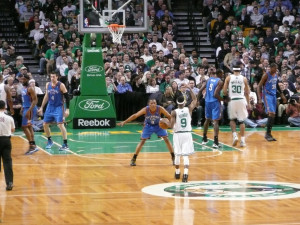6 Simple Ideas to Improve Spacing
Spacing is always a common problem facing teams in basketball. Many times throughout training sessions and games alike spacing will have a negative effect on a team’s offensive production. This problem is not just found at the junior levels of the sport either, it is an issue that faces seniors and elite levels of the sport as well.

When looked at spacing seems to be a simple aspect of the team’s offense. It is about keeping adequate distance between each player on the court. So why is this such a hurdle for players to overcome? It comes down to two factors; understanding and pressure. Players often do not have a clear understanding of what is expected from them as players within a team’s offense. Coaches often confuse instructing players about an offense, with developing their players understanding and knowledge. One develops players who learn how to follow a pattern, the other develops players who make plays.
Pressure is the other key reason why teams often faultier when it comes to maintaining good spacing. The key to overcoming this situation is to provide opportunities in training sessions initially that simulate pressure and try to force the players to break the desired positioning. This type of scenario builds experience that can be later transferred to training sessions. Then it comes down to game time and putting the discussed principles relevant to your team’s offense into play.
Below are some of the steps to help with the task of implementing and improving your team’s spacing.
Discuss the desired spacing requirement with your team; often coaches assume players understand what is wanted. This unfortunately is not always the case. Different offensive philosophies as well as offenses will have different spacing requirements. These specifics relevant to a team’s offenses and coaching philosophy need to be highlighted and explained to team members.
Breakdown offense and highlight scoring options; as an extension of the spacing demanded within a team’s offense and offensive philosophy, is the listing of the scoring options. Breaking down each movement within an offense to highlight the possible scoring options will be a vital aspect that will help with spacing. Once players understand what opportunities they should be looking for they will be more likely to avoid crowding spaces that they should not be within.
Use of rubber non-slip dots; there are some very useful pieces of equipment which can be of assistance in instructing upon spacing. As a coach, you can purchase non-slip rubber dots from most good sports equipment stores. These dots are made from a rubber compound so they do not split if stood upon, and a designed to make a complete seal when on the floor so to reduce the likelihood of them being a tripping hazard. These can be placed in specific spacing areas to help especially juniors.
Change offensive formation: another option that can be called upon is to change the offensive formation used. Different offensive formations provide different spacing demands. If a team is struggling with a 3 Out, 2 In formation, then altering this to 4 out and 1 In may provide some added space for players to work with. This option is especially useful with younger players who are struggling to understand the concepts of the offense and spacing.
Run more tactically focused drills; as athletes move through the basics of the offense they will need opportunities through breakdowns and 5 v 5 situations to practice their spacing. Selecting drills that help build this aspect such as drills involving a lot of player movement are very useful. In these types of drills players will need to be in constant motion and assessing spacing all the time, including when attacking the basket and moving into receiver spots.
Allow multiple possession offensive situations; once a team starts to show some competence in tactically focused drills, it is important to progress these challenges to multiple offensive possessions in a row while still adhering to offensive spacing principles. This allows players to make a greater range of mistakes and then more specific information can be provide to each player and the team as a whole. For example, spacing can be discussed not only in a stagnant half court context but also during fast breaks, primary transition, secondary transition and all the other half court offensive phases.
Spacing is a challenging concept to teach and instruct upon and for players, with every new offense, with every new coach there are different principles concerning spacing to learn. So the for players the learning is ongoing.






